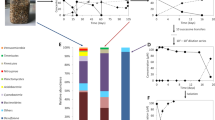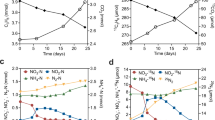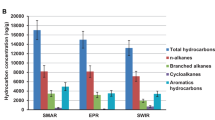Abstract
The short-chain hydrocarbons ethane, propane and butane are constituents of natural gas. They are usually assumed to be of thermochemical origin1, but biological formation of ethane and propane has been also observed2. Microbial utilization of short-chain hydrocarbons has been shown in some aerobic species3,4 but not in anaerobic species of bacteria. On the other hand, anaerobic utilization of short-chain hydrocarbons would in principle be expected because various anaerobic bacteria grow with higher homologues (≥C6)5. Indeed, chemical analyses of hydrocarbon-rich habitats with limited or no access of oxygen indicated in situ biodegradation of short-chain hydrocarbons6,7,8,9,10. Here we report the enrichment of sulphate-reducing bacteria (SRB) with such capacity from marine hydrocarbon seep areas. Propane or n-butane as the sole growth substrate led to sediment-free sulphate-reducing enrichment cultures growing at 12, 28 or 60 °C. With ethane, a slower enrichment with residual sediment was obtained at 12 °C. Isolation experiments resulted in a mesophilic pure culture (strain BuS5) that used only propane and n-butane (methane, isobutane, alcohols or carboxylic acids did not support growth). Complete hydrocarbon oxidation to CO2 and the preferential oxidation of 12C-enriched alkanes were observed with strain BuS5 and other cultures. Metabolites of propane included iso- and n-propylsuccinate, indicating a subterminal as well as an unprecedented terminal alkane activation with involvement of fumarate. According to 16S ribosomal RNA analyses, strain BuS5 affiliates with Desulfosarcina/Desulfococcus, a cluster of widespread marine SRB. An enrichment culture with propane growing at 60 °C was dominated by Desulfotomaculum-like SRB. Our results suggest that diverse SRB are able to thrive in seep areas and gas reservoirs on propane and butane, thus altering the gas composition and contributing to sulphide production.
This is a preview of subscription content, access via your institution
Access options
Subscribe to this journal
Receive 51 print issues and online access
$199.00 per year
only $3.90 per issue
Buy this article
- Purchase on Springer Link
- Instant access to full article PDF
Prices may be subject to local taxes which are calculated during checkout



Similar content being viewed by others
References
Claypool, G. E. & Kvenvolden, K. A. Methane and other hydrocarbon gases in marine sediment. Annu. Rev. Earth Planet. Sci. 11, 299–327 (1983)
Hinrichs, K.-U. et al. Biological formation of ethane and propane in the deep marine subsurface. Proc. Natl Acad. Sci. USA 103, 14684–14689 (2006)
Ashraf, W., Mihdhir, A. & Murrel, J. C. Bacterial oxidation of propane. FEMS Microbiol. Lett. 122, 1–6 (1994)
Arp, D. J. Butane metabolism by butane-grown 'Pseudomonas butanovora'. . Microbiology 145, 1173–1180 (1999)
Widdel, F., Boetius, A. & Rabus, R. in The Prokaryotes 3rd edn (eds Dworkin, M., Falkow, S., Rosenberg, E., Schleifer, K.-H. & Stackebrandt, E.) Vol. 2 1028–1049 (Springer, New York, 2006)
Gieg, L. M. & Suflita, J. M. Detection of anaerobic metabolites of saturated and aromatic hydrocarbons in petroleum-contaminated aquifers. Environ. Sci. Technol. 36, 3755–3762 (2002)
Martini, A. M. et al. Microbial production and modification of gases in sedimentary basins: A geochemical case study from a Devonian shale gas play, Michigan Basin. Bull. Am. Assoc. Petrol. Geol. 87, 1355–1375 (2003)
Wenger, L. M., Davis, C. L. & Isaksen, G. H. Multiple controls on petroleum biodegradation and impact on oil quality. Soc. Petrol. Eng. Reserv. Eval. Eng. 5, 375–383 (2002)
Sassen, R. et al. Free hydrocarbon gas, gas hydrate, and authigenic minerals in chemosynthetic communities of the northern Gulf of Mexico continental slope: relation to microbial processes. Chem. Geol. 205, 195–217 (2004)
Niemann, H. et al. Microbial methane turnover at mud volcanoes of the Gulf of Cadiz. Geochim. Cosmochim. Acta 70, 5336–5355 (2006)
Joye, S. B. et al. The anaerobic oxidation of methane and sulfate reduction in sediments from Gulf of Mexico cold seeps. Chem. Geol. 205, 219–238 (2004)
Orcutt, B. N. et al. Life at the edge of methane ice: microbial cycling of carbon and sulfur in Gulf of Mexico gas hydrates. Chem. Geol. 205, 239–251 (2004)
Simoneit, B. R. T., Kawka, O. E. & Brault, M. Origin of gases and condensates in the Guaymas Basin hydrothermal system (Gulf of California). Chem. Geol. 71, 169–182 (1988)
Whelan, J. K., Simoneit, B. R. T. & Tarafa, M. E. C1-C8 Hydrocarbons in sediments from Guaymas Basin, Gulf of California — Comparison to Peru Margin, Japan Trench and California borderlands. Org. Geochem. 12, 171–194 (1988)
Rabus, R. et al. Anaerobic initial reaction of n-alkanes in a denitrifying bacterium: Evidence for (1-methylpentyl)succinate as initial product and for involvement of an organic radical in n-hexane metabolism. J. Bacteriol. 183, 1707–1715 (2001)
Alperin, M. J., Reeburgh, W. S. & Whiticar, M. J. Carbon and hydrogen isotope fractionation resulting from anaerobic methane oxidation. Glob. Biogeochem. Cycles 2, 279–288 (1988)
Martens, C. S., Albert, B. D. & Alperin, M. J. Stable isotope tracing of anaerobic methane oxidation in the gassy sediments of Eckernförde bay, German Baltic Sea. Am. J. Sci. 299, 589–610 (1999)
Seifert, R., Nauhaus, K., Blumenberg, M., Krüger, M. & Michaelis, W. Methane dynamics in a microbial community of the Black Sea traced by stable carbon isotopes in vitro . Org. Geochem. 37, 1411–1419 (2006)
Kinnaman, F. S., Valentine, D. L. & Tyler, S. C. Carbon and hydrogen isotope fractionation associated with the aerobic microbial oxidation of methane, ethane, propane and butane. Geochim. Cosmochim. Acta 71, 272–283 (2007)
Formolo, M. J. et al. Quantifying carbon sources in the formation of authigenic carbonates at gas hydrate sites in the Gulf of Mexico. Chem. Geol. 205, 253–264 (2004)
Kallmeyer, J. & Boetius, A. Effects of temperature and pressure on sulfate reduction and anaerobic oxidation of methane in hydrothermal sediments of Guaymas Basin. Appl. Environ. Microbiol. 70, 1231–1233 (2004)
Head, I. M., Jones, D. M. & Larter, S. R. Biological activity in the deep subsurface and the origin of heavy oil. Nature 426, 344–352 (2003)
Kelley, D. S. et al. A serpentinite-hosted ecosystem: The Lost City hydrothermal field. Science 307, 1428–1434 (2005)
Plass-Dülmer, C., Koppmann, R., Ratte, M. & Rudolph, J. Light nonmethane hydrocarbons in seawater. Glob. Biogeochem. Cycles 9, 79–100 (1995)
Moser, D. P. et al. Desulfotomaculum and Methanobacterium spp. dominate a 4- to 5-kilometer-deep fault. Appl. Environ. Microbiol. 71, 8773–8783 (2005)
Ludwig, W. et al. ARB: a software environment for sequence data. Nucleic Acids Res. 32, 1363–1371 (2004)
Swofford, D. L. PAUP* 4.0: phylogenetic analysis using parsimony (and other methods). (Sinauer Associates, Sunderland, Massachusetts, 1999)
Posada, D. & Crandall, K. A. MODELTEST: testing the model of DNA substitution. Bioinformatics 14, 817–818 (1998)
Snaidr, J., Amann, R., Huber, I., Ludwig, W. & Schleifer, K.-H. Phylogenetic analysis and in situ identification of bacteria in activated sludge. Appl. Environ. Microbiol. 63, 2884–2896 (1997)
Teske, A. et al. Microbial diversity of hydrothermal sediments in the Guaymas Basin: Evidence for anaerobic methanotrophic communities. Appl. Environ. Microbiol. 68, 1994–2007 (2002)
Weber, A. & Jørgensen, B. B. Bacterial sulfate reduction in hydrothermal sediments of the Guaymas Basin, Gulf of California, Mexico. Deep-sea Res. I 49, 827–841 (2002)
Widdel, F. & Bak, F. in The Prokaryotes 2nd edn (eds Balows, A., Trüper, H. G., Dworkin, M., Harder, W. & Schleifer, K.-H.) Vol. 4 3352–3378 (Springer, New York, 1992)
Cline, J. D. Spectrophotometric determination of hydrogen sulphide in natural waters. Limnol. Oceanogr. 14, 454–458 (1969)
Aeckersberg, F., Bak, F. & Widdel, F. Anaerobic oxidation of saturated hydrocarbons to CO2 by a new type of sulfate-reducing bacterium. Arch. Microbiol. 156, 5–14 (1991)
Giese, B. & Meister, J. Die Addition von Kohlenwasserstoffen an Olefine. Eine neue synthetische Methode. Chem. Ber. 110, 2588–2600 (1977)
Giese, B. & Kretzschmar, G. Radikalische Addition an cyclische Derivate der Maleinsäure. Chem. Ber. 115, 2012–2014 (1982)
Giese, B. & Kretzschmar, G. Radikalkettenreaktionen mit Maleinsäureanhydriden. Zur kontrathermodynamischen Stereoselektrivität. Chem. Ber. 117, 3175–3182 (1984)
Acknowledgements
We are particularly indebted to the shipboard science parties and submersible operation teams of the RV Seward Johnson II and RV Atlantis, and to K. Zengler for providing sediment samples from Guaymas basin. Funding for the Gulf of Mexico cruise was provided by the US National Science Foundation (Life in Extreme Environments programme), the US Department of Energy, and the US National Oceanographic and Atmospheric Administration. We thank J. Harder, C. Karger, R. Lendt and A. Sobotta for instrumental help. S.M.S. and S.B.J. acknowledge support through a fellowship received from the Hanse Wissenschaftskolleg, Delmenhorst (Germany). This study was supported by the Max-Planck-Gesellschaft and the GEOTECHNOLOGIEN research programme of the BMBF and DFG.
The nucleotide sequences have been deposited at EMBL, GenBank and DDBJ under accession numbers EF077225 (strain BuS5), EF077226 (enrichment culture ‘Butane12-GMe’), EF077227 (enrichment culture ‘Propane60-GuB’) and EF077228 (enrichment culture with butane at 60 °C).
Author information
Authors and Affiliations
Corresponding author
Ethics declarations
Competing interests
Reprints and permissions information is available at www.nature.com/reprints.
Supplementary information
Supplementary Information.
The file contains Supplementary Figures 1-7 with Legends, Supplementary Tables 1-5 and additional references. (PDF 1871 kb)
Rights and permissions
About this article
Cite this article
Kniemeyer, O., Musat, F., Sievert, S. et al. Anaerobic oxidation of short-chain hydrocarbons by marine sulphate-reducing bacteria. Nature 449, 898–901 (2007). https://doi.org/10.1038/nature06200
Received:
Accepted:
Published:
Issue Date:
DOI: https://doi.org/10.1038/nature06200
This article is cited by
-
Candidatus Alkanophaga archaea from Guaymas Basin hydrothermal vent sediment oxidize petroleum alkanes
Nature Microbiology (2023)
-
Microbial remediation of oil-contaminated shorelines: a review
Environmental Science and Pollution Research (2023)
-
Large-scale protein level comparison of Deltaproteobacteria reveals cohesive metabolic groups
The ISME Journal (2022)
-
Low 13C-13C abundances in abiotic ethane
Nature Communications (2022)
-
Anaerobic oxidation of propane coupled to nitrate reduction by a lineage within the class Symbiobacteriia
Nature Communications (2022)
Comments
By submitting a comment you agree to abide by our Terms and Community Guidelines. If you find something abusive or that does not comply with our terms or guidelines please flag it as inappropriate.



